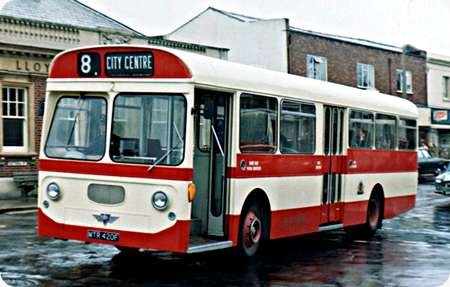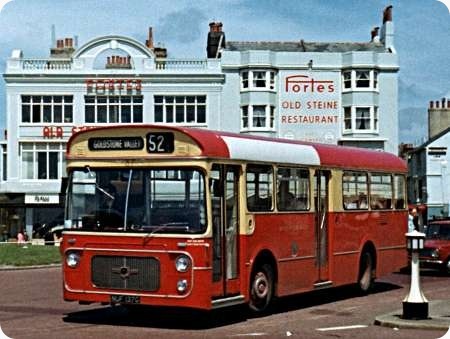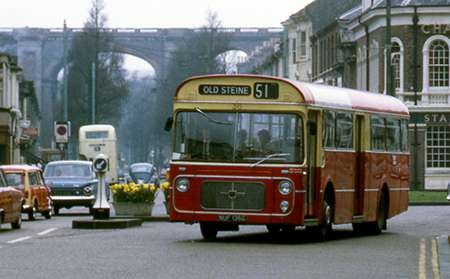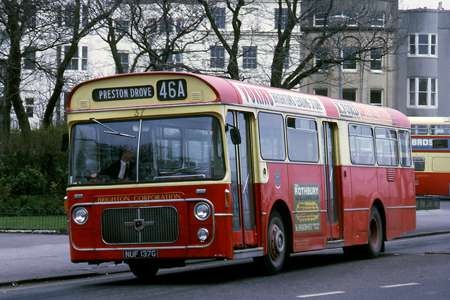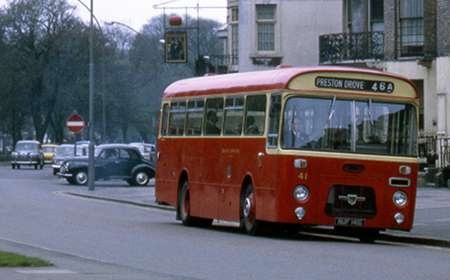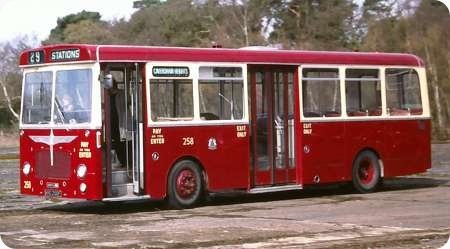Southampton Corporation - AEC Swift - MTR 420F - 2
Southampton Corporation
1968
AEC Swift MP2R
Strachans B47D
I thought a southern flavour was in order with another Southampton photo this one in service in early
1968 when the bus was quite new I am not sure of the exact location in the city.
No 2 MTR 420F was
an AEC Swift MP2R with a Strachans B47D body delivered in February 1968 one of a batch of five which
were some 9-10 months after No 1 JOW 499E with an identical body, the ways to tell them apart was that
No 1 had a red roof and a cream skirt rather than that shown on No 2 it also had a route number box
above the first near/side window. These were followed by four more Swifts in 1970 this time with East
Lancs who by this time were confirmed as Southampton’s body builder of choice.
Photograph and Copy contributed by Diesel Dave
05/06/14 - 07:38
It’s on the junction of Portsmouth Road and Victoria Road in Woolston, Dave.
She’s come from Weston Estate and is going to City Centre via Bitterne and Northam.
The 8 and
the 16 ran in opposite directions and the bus is turning right here because ahead of her is the
bridge carrying the Southampton to Portsmouth railway line. Occasionally, drivers tried taking
double deckers under the bridge, and failed to do anything other than cause the vehicle’s immediate
withdrawal, hence the introduction of the compulsory right turn here. The road was lowered when the
Itchen Bridge was built to replace the Floating Bridge in 1977.
Several
"Corporation" services ended at either side of the Itchen, and Hants & Dorset had a couple
which terminated in Woolston, along with a small depot.
Pete Davies
05/06/14 - 07:39
By the time I saw this bus it was in a rather sorry state - parked at the back of the Blackpool Corporation depot in April 1980 being used as a source of spares for their own fleet of Swifts.
Mike Morton
05/06/14 - 17:41
It’s nice to see this style of bodywork in a decent colour scheme. London Transport and Wolverhampton’s versions were both dreadful!
Neville Mercer
05/06/14 - 17:41
I recall seeing these vehicles on my occasional forays from Portsmouth to So’ton. They had attractive bodies, in my opinion, aided by the livery. I moved from the area in 1976, the same year that saw the demise of Strachans. Your comment, Mike, confirms my thoughts that they did not have long lives, like many Swifts. No idea of bodywork quality: do you DD?
Chris Hebbron
06/06/14 - 07:39
The six Strachans bodied Swifts lasted a maximum of eleven years in Southampton, but a couple of them went after a mere six years. The subsequent four Swifts with East Lancs bodies also stayed in the fleet for just eleven years, so I suspect that the modest lives of these buses was due more to the shortcomings of the Swift chassis than to inadequacies with the bodywork. In fact, the Strachans body on rear engined two door single deck chassis gained quite a reasonable reputation owing to the employment of underframing that reduced the flexing movement. The Strachans examples were rather less prone to roof structure failure in the region of the centre doorway than the efforts of some other manufacturers, as London Transport, for example, discovered to its cost.
Roger Cox
06/06/14 - 08:46
One peculiarity of the Swifts in Southampton - it may have applied to the Arab UF and Nimbus fleet as well but I never got to travel on any of them, and I suspect not - was a red stripe across the roof, to match the location of the step behind the centre door. Smoking downstairs had been prohibited for several years, but was still allowed upstairs. On the Swifts, the step and stripe designated where the ‘upstairs’ was!
Pete Davies
07/06/14 - 08:17
Roof? No, sorry! I meant ceiling!
Pete Davies
07/06/14 - 08:17
I had always wondered how cigarette smoke determined where to stop blowing. It
was commonplace for Smokers to be requested to occupy the rear of the vehicle on single deck buses.
But how to keep the smoke from wafting into the forward section?
Southampton clearly had the
answer - paint a read line across the ceiling, the smoke won’t dare go beyond there. Obvious, or
what !!
Petras409
07/06/14 - 08:18
Thx, Roger, your thoughts about the chassis rather than the body being the problem matches mine.
Chris Hebbron
07/06/14 - 10:00
Slightly off topic but there used to be an airline that had smokers on one side of the aircraft, non smokers on the other and this was on narrow bodied aircraft. The joke was that this must be Aer Lingus. The truth was it was Lufthansa. Just how German efficiency prevented the smoke crossing the aisle on a B737 for instance has never been revealed.
Phil Blinkhorn
Quick links to the - Comments Page - Contact Page - Home Page
